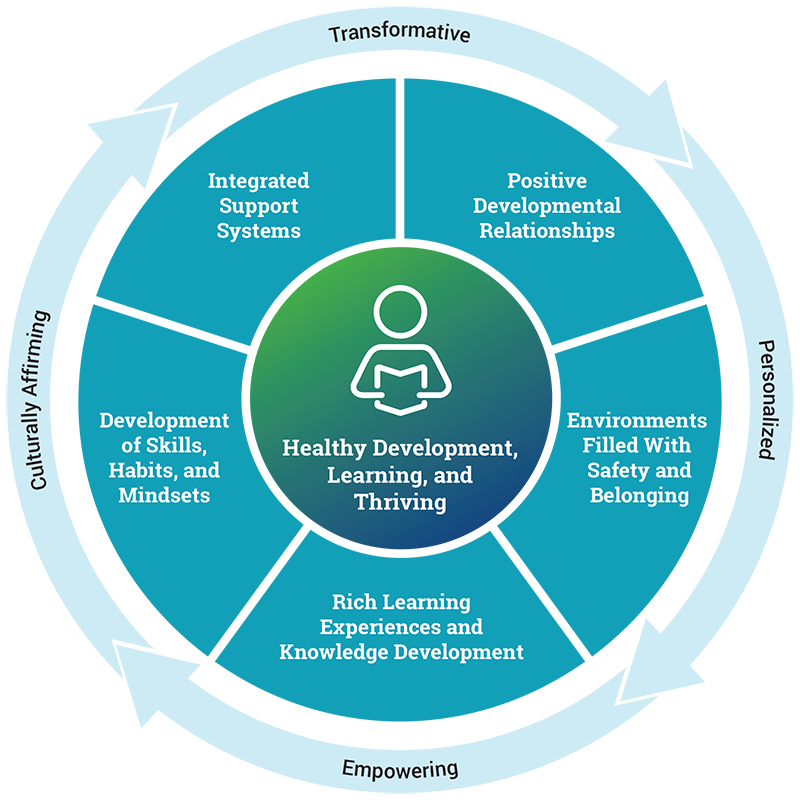“Education then, beyond all other devices of human origin, is the great equalizer of the conditions of men, the balance-wheel of the social machinery.”
—Horace Mann, 1848
Furthermore, there has been a siloing of systems in the United States that has led to disconnected, piecemeal policymaking and inefficient use of critical funds. K–12 education has been positioned as separate from other systems that serve children and youth, including early childhood education, physical and mental health, child and family services, after-school and out-of-school time, juvenile justice, and higher education. The failure to address the full spectrum of education and child development has contributed to the inequitable outcomes we continue to see today.
To achieve the transformation we need today, education and all youth-serving systems must be willing to embrace what we know about how children learn and then develop. Whole child policy addresses each of the elements of the systems that influence children’s opportunities to learn. It builds on the knowledge established through the science of learning and development, which shows that the range of students’ academic skills and knowledge—and, ultimately, students’ potential—can be significantly influenced through exposure to learning environments that use whole child design.  These designs are relationship-centered and filled with safety and belonging; provide rich learning experiences and opportunities to develop essential skills, mindsets, and habits; and ensure access to integrated support systems. Whole child design—of both schools and systems—must guide the next generation of policymaking and practice if educational outcomes are to be substantially improved.
These designs are relationship-centered and filled with safety and belonging; provide rich learning experiences and opportunities to develop essential skills, mindsets, and habits; and ensure access to integrated support systems. Whole child design—of both schools and systems—must guide the next generation of policymaking and practice if educational outcomes are to be substantially improved.
To facilitate this transformation, this toolkit describes evidence-based practices and policies that can become the foundation for a new way of policymaking to improve outcomes for children and youth. Whole child policy principles suggest not a single pathway to systemic change but rather an approach that supports the development of the full set of skills, competencies, and mindsets that all young people need to live and thrive in their diverse communities.
Whole Child Policy Principles
When education policymaking is grounded in whole child principles, it takes the following forms:
- Policy that is grounded in the science of learning and development and supportive of students’ academic, cognitive, social and emotional, and identity development, as well as their mental and physical health and well-being
- Policy that is made collaboratively, across child-, youth-, and family-serving agencies and institutions, informed by stakeholders, and guided by a shared whole child vision
- Policy in which all policymakers and stakeholders in child-, youth-, and family-serving systems hold collective responsibility for how policy affects children and youth; this includes education (early childhood to young adulthood), health and human services, juvenile justice, youth development, child welfare, housing/homelessness, and workforce initiatives
- Policy that creates the enabling conditions for and removes barriers to successful implementation of rich, developmentally appropriate educational experiences within schools, districts, and communities
- Funding and resources that are distributed efficiently and are equitably based on student need
- From the state level down to the classroom, policy that uses data for continuous systemic improvement—to detect gaps in resource allocation, assess areas of strength and areas for growth, and inform plans for continuous improvement
Creating Systems Change
Developing and sustaining whole child education grounded in the science of learning and development requires both a new policy agenda and comprehensive systems change. To give every student the opportunity to thrive, U.S. education systems must be informed by the growing body of research on how children learn and develop. The advancement and sustainability of whole child education will require simultaneous and reinforcing work streams that address how and what policy gets made, how schools and other learning spaces are designed, and how practitioners are prepared and supported.
The Whole Child Policy Toolkit aims to tackle one piece of this work by supporting states in adopting a whole child policy approach. Developed by the Learning Policy Institute with our
The toolkit builds upon two playbooks, Design Principles for Schools and Design Principles for Community-Based Settings, that provide a framework to guide the transformation of k–12 and community-based learning settings and illustrate how practitioners can implement practices and structures that support whole child learning and development. Co-created by the Learning Policy Institute, Turnaround for Children, and the Forum for Youth Investment, the Design Principles playbooks leverage the deep knowledge and expertise of the educational ecosystem, including educators, counselors, curriculum and tool developers, and community-based organizations to translate key findings from the science of learning and development into concrete practices and structures that can guide the transformation of schools, districts, and youth-serving organizations.

Implementing a whole child approach requires educators with the knowledge, skills, and dispositions to do so. This will require both an examination of the “what” of practitioner preparation and development—the content that educators and leaders need to learn about children’s development—and the “how”—the strategies that practitioners must develop to produce deep understanding; useful skills; and the capacity to reflect, learn, and continue to improve. One collaborative effort—the Educator Preparation Laboratory (EdPrepLab)—is currently underway to build the capacity of preparation programs to strengthen educator preparation in the United States. This initiative, led by the Learning Policy Institute and Bank Street College, brings together a growing network of pioneering preparation programs to support them in documenting, sharing, and strengthening their practices. EdPrepLab also recognizes the importance of working with preparation institutions and state agencies to incorporate the knowledge, skills, and dispositions educators need into the expectations, designs, and accountability standards for educator licensing and accreditation. The Learning Policy Institute, in partnership with EdPrepLab institutions, is developing and refining design principles based on the science of learning and development for educator preparation programs, which will set a vision for the redesign of pre-service and in-service preparation and create a collaborative network of practitioners working on implementing the principles.
Achieving Systems Change
To achieve the transformation toward whole child design, education systems—from policy to practice—must be willing to rethink and rebuild those systems around what we know about how children learn and develop. And what we know is this: Students’ academic success—and, ultimately, their potential as human beings—can be significantly influenced by learning environments that use whole child design. These learning environments are safe, inclusive, and relationship-centered, and they provide students with rich learning experiences that help them build the skills, knowledge, and mindsets to thrive in school and life. Whole child learning environments are foundational to supporting the learning and development of all young people. The policy strategies and actions found in this toolkit can help transform education systems and give schools, districts, and communities the tools and resources they need to ensure every child has access to learning environments that meet their learning and developmental needs.